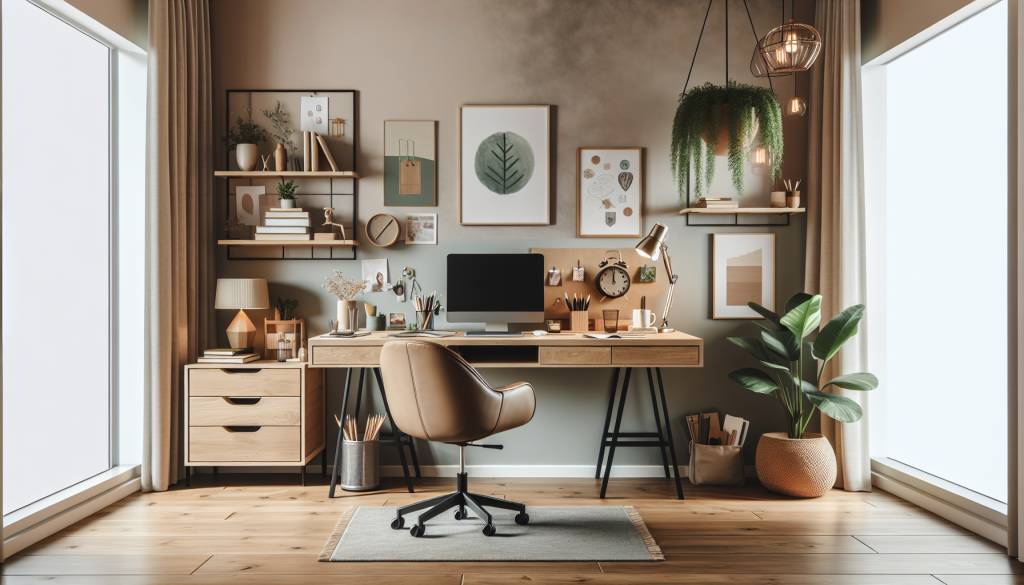In our new era of remote work, creating a dedicated home office space has never been more important. Productivity can be greatly influenced by your work environment, and a well-designed home office can make a significant difference. Here are some DIY home office ideas that can help enhance your remote work productivity.
Choosing the Right Space
The first step in creating a home office is to select the right space. Opt for an area with minimal distractions. Ideally, this space should be separate from high-traffic areas in your home. If you’re working in a smaller space, consider converting a closet or a corner of a room into your workspace.
- Natural Light: Choose a space that receives natural light. Natural light can improve your mood and productivity.
- Quiet Area: Ensure your workspace is quiet, away from the hustle and bustle of household activities.
Essential Furniture
Your home office furniture should be both functional and comfortable. Here are some key pieces to consider:
- Desk: A sturdy desk is essential. Consider DIY options like converting an old door or wooden slabs into a desk.
- Chair: Invest in an ergonomic chair to support your posture. You can even reupholster an old chair to match your home office decor.
- Shelves: Floating shelves or repurposed bookshelves can store office supplies and are a useful addition.
Organization and Storage Solutions
Keeping your workspace organized is crucial for productivity. Implement clever storage solutions to keep your office clutter-free:
- Drawer Organizers: Use drawer organizers for pens, papers, and other small office supplies.
- Filing System: A filing cabinet or wall-mounted file organizer can help you keep important documents sorted and easily accessible.
- Cable Management: Use cable ties and clips to keep your cords organized and untangled.
Personalization and Decoration
Adding personal touches to your home office can make it feel more inviting. Consider incorporating the following ideas:
- Art and Décor: Hang inspirational artwork or photos on the walls.
- Plant Life: Incorporate houseplants to enhance air quality and provide a natural element.
- Color Scheme: Stick to a calming color palette to create a conducive working environment.
Lighting
Proper lighting can reduce eye strain and improve focus. Here are some lighting tips for your home office:
- Task Lighting: An adjustable desk lamp can provide direct lighting for reading and writing.
- Ambient Lighting: Overhead lights or floor lamps can provide general lighting for the entire room.
- Natural Light: Position your desk near a window to utilize natural light during the day.
Technology and Office Gadgets
Incorporating the right technology can make your workday more efficient. Consider the following essentials:
- Office Equipment: A reliable computer, printer, and high-speed internet connection are indispensable.
- Noise-Canceling Headphones: These can help you concentrate in a noisy environment.
- Smart Storage Solutions: Cloud storage and external hard drives can keep your digital files organized and backed up.
Comfort and Ergonomics
Ensuring your home office is ergonomic can prevent fatigue and increase productivity. Consider these tips:
- Proper Desk Height: Your desk should allow you to type with your wrists straight and your elbows at right angles.
- Monitor Position: Your monitor should be at eye level to prevent neck strain.
- Foot Support: Use a footrest if your feet don’t comfortably reach the ground.
DIY Projects to Personalize Your Space
Engaging in DIY projects can make your home office truly unique. Here are some simple DIY ideas:
- Custom Bulletin Board: Create a bulletin board by covering a corkboard with fabric that matches your office decor.
- DIY Desk Organizer: Use recycled materials like cans, jars, and boxes to create customized desk organizers.
- Wall Art: Paint or stencil a feature wall to add a touch of creativity to your space.
Creating a Routine and Boundaries
Once your home office is set up, maintaining a routine and setting boundaries is key to staying productive:
- Consistent Schedule: Set regular work hours and stick to them.
- Break Times: Schedule breaks to avoid burnout. Use these times to step away from your desk and refresh your mind.
- Work-Life Balance: Ensure your workspace is used solely for work, helping you mentally separate work from home life.
Transforming a part of your home into a productive workspace doesn’t have to be daunting. With the right strategies and a bit of creativity, you can create a home office that not only boosts your productivity but also suits your style and needs. By carefully selecting your space, investing in key furniture pieces, and incorporating personalized touches, you’ll be well on your way to a more efficient and enjoyable work-from-home experience.
